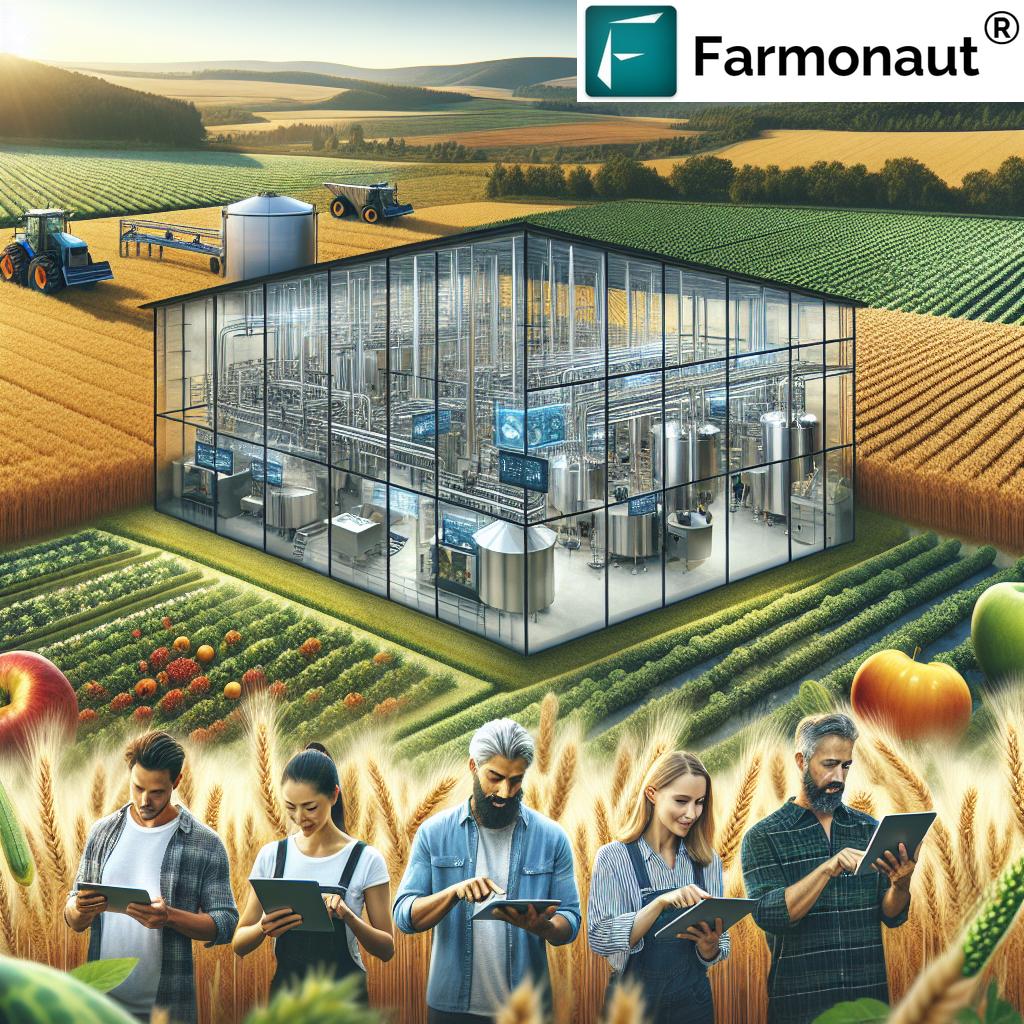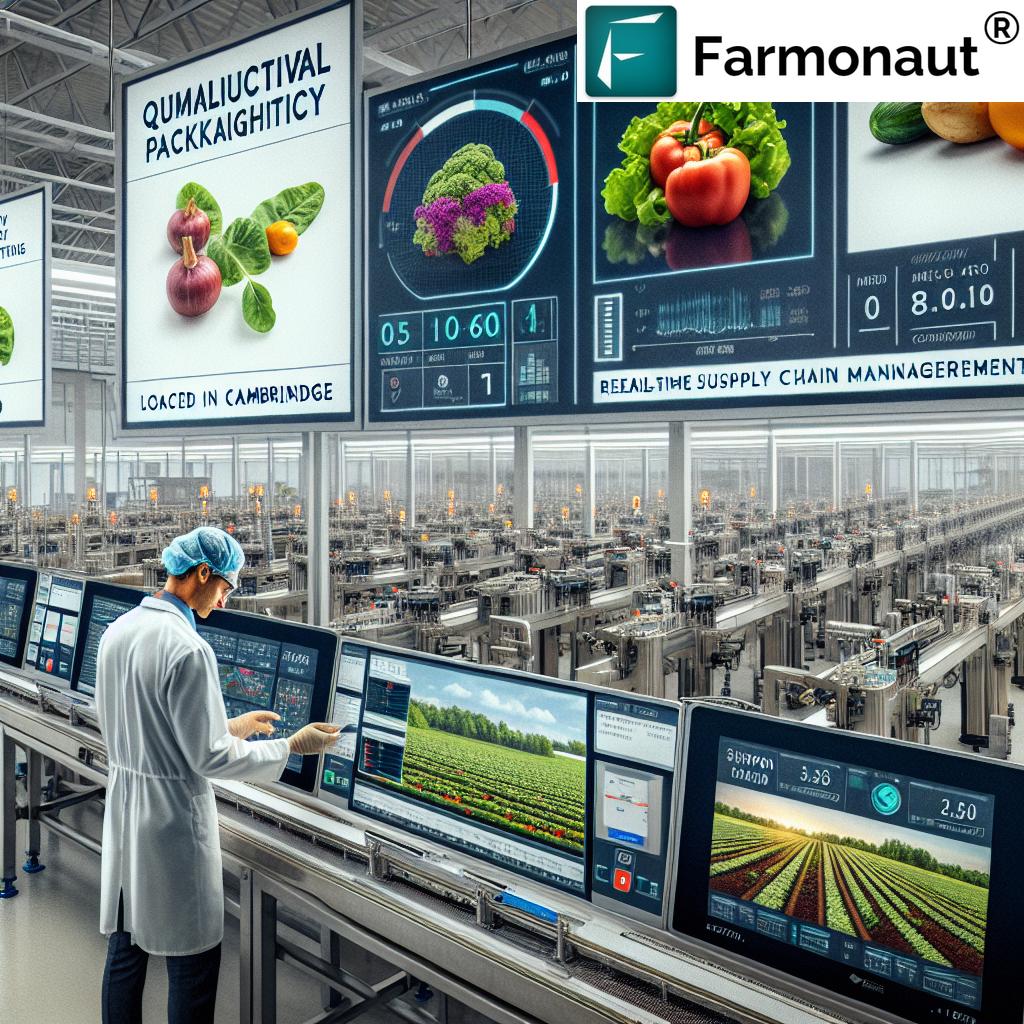Ontario’s Rural Economic Boost: $3M Grant Fuels Food Processing Innovation and Job Security
“A $3 million grant to a Cambridge snack food plant will upgrade seasoning and packaging lines, supporting local economic growth.”
In a significant move to bolster Ontario’s rural economy and food processing sector, we are witnessing a remarkable transformation in the heart of Cambridge. The recent announcement of a $3 million grant to a local snack food plant marks a pivotal moment in the province’s commitment to agricultural innovation and economic development. This investment is not just about upgrading machinery; it’s about securing jobs, enhancing local produce sourcing, and shaping the future of Canada’s food processing industry.
As experts in precision agriculture and remote sensing, we at Farmonaut recognize the immense potential this funding holds for the entire agri-food ecosystem. Let’s delve into how this grant is set to revolutionize the landscape of Ontario’s agricultural technology and economic growth strategies.
The Power of Agritech Funding Programs
The $3 million grant is part of a larger initiative aimed at fostering rural economic development and enhancing food processing technology. This program aligns perfectly with the growing need for smart farming systems and sustainable agricultural practices. Here’s how the funding is expected to make a difference:
- Upgrading seasoning and packaging lines
- Enhancing agricultural supply chain management
- Supporting local food production innovation
- Creating and securing jobs in the rural sector
These improvements are not just about modernizing a single plant; they represent a broader commitment to advancing the entire agri-food sector in Ontario.

Local Impact: Cambridge Plant at the Forefront
The Cambridge snack food plant, a cornerstone of the local economy, is set to be the primary beneficiary of this grant. With 95% of its materials sourced from Ontario farmers, this investment will have a ripple effect throughout the agricultural community. Let’s break down the expected impacts:
- Increased demand for local produce
- Enhanced processing capabilities
- Improved efficiency in production lines
- Strengthened ties between farmers and processors
This investment is a testament to the government’s recognition of the vital role that food processing plays in Ontario’s economic vitality.
Sustainable Farming Practices: A Core Focus
At Farmonaut, we understand the importance of sustainable farming practices in today’s agricultural landscape. The grant’s focus on upgrading technology aligns perfectly with our mission to make precision agriculture accessible to farmers worldwide. Here’s how sustainable practices are being promoted:
- Implementation of energy-efficient processing equipment
- Reduction of waste through improved packaging systems
- Optimization of resource use in food production
- Encouragement of environmentally friendly farming methods
These initiatives not only benefit the environment but also contribute to the long-term sustainability of Ontario’s agricultural sector.
Agricultural Investment Opportunities on the Rise
The $3 million grant is just the beginning. It signals a broader trend of increasing agricultural investment opportunities in Ontario. Here’s what this means for the sector:
- Attraction of more private investments in agritech
- Creation of a fertile ground for startups and innovation
- Expansion of research and development in agricultural technologies
- Potential for more grants and funding programs in the future
This investment climate is creating a robust ecosystem where technology and agriculture intersect, fostering growth and innovation.
The Role of Precision Agriculture Sensors
As leaders in satellite-based farm management solutions, we at Farmonaut are particularly excited about the potential for precision agriculture sensors in this new landscape. These technologies are crucial for:
- Real-time crop health monitoring
- Optimal resource allocation
- Informed decision-making for farmers
- Increased yields and reduced waste
The integration of such technologies in food processing plants can lead to more efficient production lines and better quality control.
“The Cambridge plant sources 95% of its materials from Ontario farmers, showcasing strong local agricultural supply chain integration.”
Crop Yield Optimization Techniques: A Game Changer
With the upgrade of processing facilities, there’s an increased focus on crop yield optimization. This is where Farmonaut’s expertise comes into play. Our advanced technologies offer:
- Satellite-based crop monitoring
- AI-driven insights for better farm management
- Weather forecasting for proactive farming
- Data-driven decision support for farmers
These techniques not only benefit farmers but also ensure a steady and high-quality supply of raw materials to processing plants like the one in Cambridge.

Smart Farming Systems: The Future of Agriculture
The grant’s focus on technology upgrades paves the way for the integration of smart farming systems. These systems represent the future of agriculture, offering:
- Automated processes for increased efficiency
- Data-driven insights for better decision-making
- Reduced environmental impact through precision resource use
- Enhanced traceability from farm to table
As these systems become more prevalent, we can expect to see a transformation in how food is produced, processed, and distributed across Ontario.
Economic Impact: A Closer Look
To better understand the potential impact of this $3 million grant, let’s examine a comparative analysis of the economic factors before and after the investment:
| Economic Factors | Pre-Investment | Post-Investment (Estimated) |
|---|---|---|
| Jobs at the Cambridge plant | 250 | 275 |
| Local sourcing percentage | 95% | 97% |
| Processing capacity (tons/day) | 50 | 65 |
| Technology upgrade level (scale 1-10) | 6 | 9 |
| Economic contribution to Ontario ($ millions/year) | 75 | 90 |
This table clearly illustrates the significant improvements expected across various economic indicators, highlighting the grant’s potential to drive growth and innovation in the region.
Job Security and Creation in the Food Processing Sector
One of the most significant impacts of this investment is on job security and creation. The upgrades to the Cambridge plant are expected to:
- Secure existing jobs by improving plant competitiveness
- Create new positions to operate advanced equipment
- Increase demand for skilled workers in food technology
- Stimulate indirect job creation in supporting industries
This focus on employment aligns with the broader goal of strengthening Ontario’s rural economy and creating sustainable career opportunities in the agri-food sector.
Local Produce Sourcing: Strengthening Agricultural Ties
The Cambridge plant’s commitment to sourcing 95% of its materials from Ontario farmers is a model for local agricultural support. With the new upgrades, we can expect:
- Increased capacity to process local produce
- Stronger partnerships between farmers and processors
- Reduced transportation costs and carbon footprint
- Enhanced traceability and quality control
This focus on local sourcing not only supports Ontario’s farmers but also ensures fresher, high-quality ingredients for consumers.
The Future of Canada’s Food Processing Industry
The $3 million grant to the Cambridge plant is a microcosm of the broader changes occurring in Canada’s food processing industry. Looking ahead, we can anticipate:
- Increased automation and AI integration in processing
- Greater focus on sustainable and eco-friendly packaging
- Enhanced food safety measures through technology
- More diverse product offerings to meet changing consumer demands
These advancements will position Canada as a leader in innovative food processing, attracting further investments and opportunities.
Farmonaut’s Role in Agricultural Advancement
As a company dedicated to making precision agriculture accessible, Farmonaut sees tremendous potential in these developments. Our technologies, including satellite-based crop monitoring and AI-driven insights, can significantly contribute to:
- Optimizing crop yields for food processors
- Enhancing supply chain management
- Providing data-driven solutions for sustainable farming
- Supporting food traceability initiatives
We’re excited about the possibilities that arise when cutting-edge technology meets traditional farming practices.
Explore Farmonaut’s solutions:
For developers interested in integrating our technology:
The Ripple Effect on Rural Economic Development
The impact of this grant extends far beyond the walls of the Cambridge plant. Rural economic development is set to benefit in numerous ways:
- Increased income for local farmers supplying the plant
- Growth in supporting industries like transportation and packaging
- Attraction of skilled workers to rural areas
- Boost to local retail and service sectors
This investment is a catalyst for broader economic growth, revitalizing rural communities across Ontario.
Challenges and Opportunities in Implementation
While the grant presents exciting opportunities, it’s important to acknowledge the challenges that come with implementing new technologies:
- Training workforce for new equipment and processes
- Ensuring smooth integration of new systems with existing operations
- Managing potential short-term disruptions during upgrades
- Adapting to changing market demands and consumer preferences
However, these challenges also present opportunities for innovation and growth, pushing the industry to evolve and improve.
The Role of Government in Agricultural Innovation
This grant exemplifies the crucial role that government support plays in driving agricultural innovation. Moving forward, we can expect:
- More targeted funding programs for agritech initiatives
- Policies promoting sustainable farming practices
- Collaborations between government, industry, and research institutions
- Incentives for adopting innovative agricultural technologies
Such support is vital for keeping Canada’s agricultural sector competitive on the global stage.
Consumer Benefits: From Farm to Table
Ultimately, these advancements in food processing technology will benefit consumers in several ways:
- Higher quality, fresher products
- Increased variety of locally sourced foods
- Better traceability and food safety
- Potentially lower prices due to increased efficiency
As the food processing industry evolves, consumers can look forward to a more diverse and sustainable food supply.
Conclusion: A Bright Future for Ontario’s Agri-Food Sector
The $3 million grant to the Cambridge snack food plant is more than just a financial boost; it’s a vote of confidence in the future of Ontario’s agri-food sector. As we’ve explored, this investment touches on every aspect of the agricultural supply chain, from farm to table. It promotes innovation, supports local farmers, creates jobs, and pushes the boundaries of what’s possible in food processing technology.
At Farmonaut, we’re excited to be part of this evolving landscape. Our precision agriculture solutions align perfectly with the industry’s move towards smarter, more sustainable farming practices. As Ontario’s rural economy grows and transforms, we remain committed to providing farmers and agribusinesses with the tools they need to thrive in this new era of agricultural innovation.
The future of Ontario’s agri-food sector is bright, driven by technology, supported by government initiatives, and rooted in the strength of local communities. As we move forward, we anticipate even greater advancements, more sustainable practices, and a robust, resilient food system that benefits everyone from farmers to consumers.
Experience Farmonaut on your mobile device:
FAQs
Q: How will the $3 million grant specifically impact job security at the Cambridge plant?
A: The grant is expected to secure existing jobs by improving the plant’s competitiveness and efficiency. Additionally, it may create new positions to operate and maintain the upgraded equipment, potentially increasing the total number of jobs at the facility.
Q: What types of technology upgrades are expected at the Cambridge plant?
A: The upgrades will focus on improving seasoning and packaging lines. This may include automated systems, advanced quality control mechanisms, and more efficient processing equipment, all aimed at enhancing productivity and product quality.
Q: How does this investment contribute to sustainable farming practices?
A: The investment promotes sustainability by encouraging more efficient use of resources, reducing waste through improved packaging, and potentially incorporating energy-efficient technologies. It also strengthens local supply chains, reducing transportation-related emissions.
Q: Will this grant lead to an increase in local produce sourcing?
A: Yes, the plant already sources 95% of its materials from Ontario farmers, and this investment is likely to increase that percentage. The upgrades will allow for greater processing capacity, potentially leading to increased demand for local produce.
Q: How can farmers benefit from these developments in food processing?
A: Farmers can benefit through increased demand for their produce, potentially higher prices due to the plant’s improved efficiency, and opportunities to engage with more advanced agricultural practices that align with the upgraded processing capabilities.






